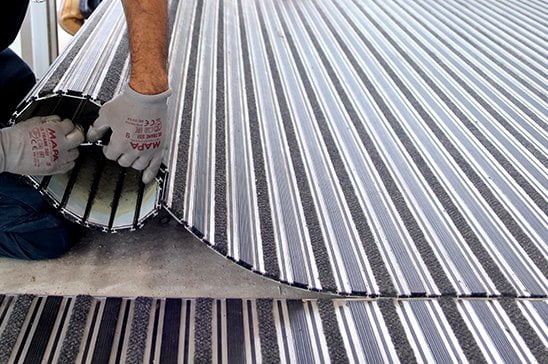The Health & Safety Executive (HSE) Slips & Trips Bulletin issued this week highlights the case of an employee who slipped on an icy floor surface in a food manufacturing business. The natural instinct for most people when falling is to reach out and grab something to save themselves. This is exactly what happened but in this case, it was some sharp equipment that ended up taking the tips of two fingers off.
This highlighted again how serious slip-accidents can be and that everyone is in danger of slipping, especially where there is exposure to snow or rain. Any moisture increases the hazard of slipping.
Slips are so often associated with bruises and broken bones, but the reality is they can be even more serious and can lead to paralysation or death. That is why slip-prevention in the workplace, and pedestrian areas in general for that matter, is so essential; potentially life-saving in actual fact.
Public walkways and factory walkways, ramps and steps can be made safer through the installation of COBAGRiP range, which features a hard wearing Silicone Carbide gritted surface that has excellent slip-resistant properties. COBAGRiP has undergone thorough testing for slip resistance and conforms to recognized industry standards: DIN 51130:2010 and BS7976-2:2010.
If you are not sure, what slip resistance is required for your site, have a look at our guide to slip resistance to gain further knowledge of slip resistance.
Manufactured from UV stabilized GRP, it is suitable for both indoor and outdoor use, and is available in GRP sheets, GRP Stair Treads and GRP Stair Nosing. GRP is extremely robust making it suitable for heavy-duty installations. COBAGRiP sheets can even withstand the weight of forklift trucks.
Choosing the right glue for your application can become tricky if you do not have the experience. This guide will assist you in selecting the correct adhesive for our COBAGRiP® product range and what other considerations one should make when installing GRP products on site.
COBAGRiP can be glued or screwed to an existing floor surface making installation relatively simple and hassle-free with minimum inconvenience.
What conditions need to be considered when using adhesive for COBAGRiP® Range?
Each site would have its unique conditions that play a role in which adhesive would be best for the specific site. Here are some of the factors that you need to look at to choose the correct adhesive:
- Weather
- Traffic Volumes
- Traffic Type
- Sunlight
- Installation surface
What effect does the weather have on an adhesive for the COBAGRiP® Range?
Temperature changes can cause a change in adhesive properties. Low temperatures cause the adhesive to become more brittle (reduced strain to failure), while high temperatures cause the adhesive to become more ductile, making it less strong and more liable to creep.
What effect does traffic volume & type have on an adhesive?
The heavier the traffic and the higher the traffic volume, the stronger the adhesive needs to be to prevent the stair noising or tread from lifting off the surface and causing a trip hazard.
What effect does sunlight have on adhesive for the COBAGRiP® Range?
Areas that have high volumes of sunlight need to be investigated to ensure that the correct adhesive is used to cope with harsh temperatures.
What effect does the surface have on the adhesive for the COBAGRiP® Range?
This is a very important aspect to consider when choosing your adhesive as additional preparation might be needed to ensure that the area is ready for the specific adhesive needed for the stair tread, stair noising or GRO sheet.
- Concrete Surface – Concrete is a porous material, so a sealer is required to prevent adhesive being absorbed into the surface. It is also important that the surface is smooth to avoid any lumps or bubbles.
- Wooden Decks – The wood needs to be smoothed out to avoid lumps. A proper wood sealer is of utmost importance when installing our COBAGRiP® Range onto wooden surfaces.
- Tiled areas – The area needs to be cleaned before installation takes place. Also, a note needs to be done regarding the grouting lines, especially when a product like the COBAGRiP® Range is installed.
What site preparation is required for our COBAGRiP® Range?
Surfaces need to be properly cleaned before and during the respective installation process. Failure to do this can result in the product failing in the early stages already.
With autumn nearly upon us now is the time to start planning for the colder months ahead. Choose from COBAGRiP Sheet (5mm or 2.4mm thick) or COBAGRiP Stair Treads and COBAGRiP Nosing with DDA compliant yellow edging.
With stair treads or grip sheets that are installed, it is always recommended, that the material is installed in a room temperature condition. The material that is going to be installed, also to be clean from any dirt, oil & dust.
On any product and any surface, one always needs to ensure that all correct procedures are followed.
What tools are required for our COBAGRiP® Range?

What glue should I use when installing the COBAGRiP® Range?
General Contact Adhesive
Contact Adhesive, a.k.a. Contact Cement is a neoprene rubber adhesive that makes for a permanent, quick and flexible bond. Contact cement is the go-to adhesive.
This adhesive is only suitable for areas that see no sunlight whatsoever. When using this glue, it is important to ensure that both surfaces have glue applied to them. You then need to wait for about 20 min to get tacky before applying the two surfaces to each other. Each application will be unique, and so the amount of glue being used will differ from product to product and application to application.
Two-Part Epoxy Glue
Two-component epoxy adhesives feature unique versatility in application and performance. This adhesive consists of a resin and a hardener.
Once this glue dries, you will not be able to clean it up or even remove it. So very special precautions need to be taken when this glue is used. This type of glue is ideal for areas of direct sunlight.
Silicone
Silicone itself is made up of carbon, hydrogen, oxygen and silicon. Note that the ingredient contained within silicone is spelt differently. The ingredient silicon comes from silica which is derived from sand.
Depending on the products and color, this to be used on any small gaps around the area to provide a professional finish to the installation.
Super Glue
The main ingredient in super glue is cyanoacrylate, C5H5NO2, for the chemistry buffs out there. Cyanoacrylate is an acrylic resin that cures almost instantly.
If all the instructions are followed on the installation of these products, one should not need Super Glue as it tends to make the material more brittle over time.
Cleaning & Maintenance of the COBAGRiP® Range
Once the product has been installed, ensure that the area is cleaned from any left-over glue, debris and any other rubbish that might be laying around.
To maintain the effectiveness of the grit that provides slip resistance, the top surface must be kept clean. Individual circumstances will vary but, generally, a stiff hand brush and hot soapy water will achieve good results. Mild detergents can be used safely on the product, but it is advisable to test any cleaning products first. Where circumstances allow our fibreglass products can be power washed without causing harm. Care should be taken when the product has been stuck down and / or edge sealed as very high-pressure power washing or repeated power washing could cause damage to sealants and adhesives.
Why take risks with floor safety when prevention is so simple? Get in touch with our sales team at COBA Europe for further information.








